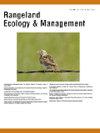了解科罗拉多州东北部牧场主如何适应干旱
IF 2.4
3区 环境科学与生态学
Q2 ECOLOGY
引用次数: 0
摘要
随着美国西部牧场主面临更严重的干旱和牧草生产的变异性增加,他们的经营和相关的农村社区面临更大的干旱影响脆弱性。预计该地区干旱的严重程度和持续时间会增加,这表明了解具体情况的反应可以使我们更有效地应对干旱。我们采用了一种混合方法(邮件调查和焦点小组)来了解影响个体牧场主观察到的适应性反应和使用决策指标来应对干旱的因素。我们发现,与其他牧场系统一样,科罗拉多短草草原牧场主在面对资源可变性、生态复杂性和其他超出其控制的压力因素(如气候和饲料谷物市场)等障碍时,有动力通过灵活的管理和多样化的收入来源来维持经济上可行的运营。最常见的适应策略是保持保守的放养率;然而,牧场主也使用了现场干旱指标,如土壤水分减少、夏季降水减少和植物高胁迫。我们的研究表明,在科罗拉多州东北部,传统的牧场管理与保守的放养率可能是适应性管理的一个例子。我们的研究表明,了解环境对评估牧场社区的适应行动至关重要。本文章由计算机程序翻译,如有差异,请以英文原文为准。
Understanding How Ranchers Adaptively Manage for Drought in Northeastern Colorado
As ranchers in the western United States face more severe droughts with increased variability in forage production, their operations and associated rural communities face heightened vulnerability to drought impacts. Predicted increases in the severity and duration of droughts in this region suggest that understanding context-specific responses could allow for more effective drought responses. We employed a mixed-methods approach (mail surveys and focus groups) to understand factors that influence individual rancher's observed adaptive response and use of decision-making indicators to respond to drought. We find that, like other rangeland systems, Colorado shortgrass steppe ranchers are motivated to maintain an economically viable operation through flexible management and diverse income sources in the face of barriers like resource variability, ecological complexity, and other stressors beyond their control (e.g., climate and feed grain markets). The most common adaptation strategy was maintaining conservative stocking rates; however, ranchers also used on-site drought indicators such as decreased soil moisture, decreased summer precipitation, and high plant stress. Our research suggests that in NE Colorado, traditional rangeland management with conservative stocking rates may be an example of adaptive management. Our research suggests that it is critical to understand context to assess the adaptive actions of ranching communities.
求助全文
通过发布文献求助,成功后即可免费获取论文全文。
去求助
来源期刊

Rangeland Ecology & Management
农林科学-环境科学
CiteScore
4.60
自引率
13.00%
发文量
87
审稿时长
12-24 weeks
期刊介绍:
Rangeland Ecology & Management publishes all topics-including ecology, management, socioeconomic and policy-pertaining to global rangelands. The journal''s mission is to inform academics, ecosystem managers and policy makers of science-based information to promote sound rangeland stewardship. Author submissions are published in five manuscript categories: original research papers, high-profile forum topics, concept syntheses, as well as research and technical notes.
Rangelands represent approximately 50% of the Earth''s land area and provision multiple ecosystem services for large human populations. This expansive and diverse land area functions as coupled human-ecological systems. Knowledge of both social and biophysical system components and their interactions represent the foundation for informed rangeland stewardship. Rangeland Ecology & Management uniquely integrates information from multiple system components to address current and pending challenges confronting global rangelands.
 求助内容:
求助内容: 应助结果提醒方式:
应助结果提醒方式:


